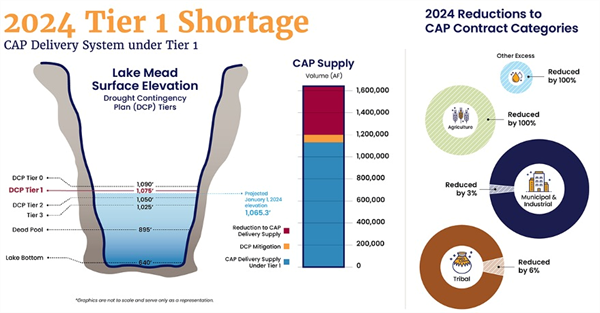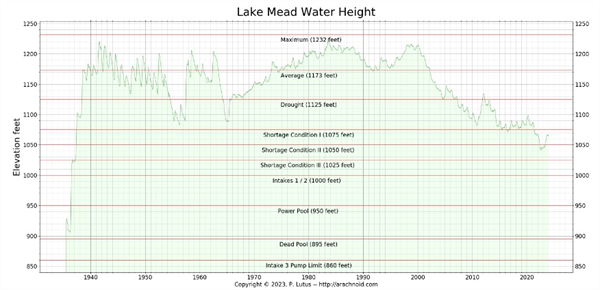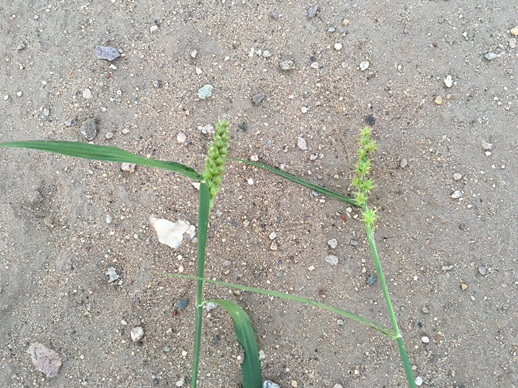
In 2023 Arizona and the lower basin states were operating under Tier 2 reductions, consistent with the Drought Contingency Plans (DCP) for Colorado River conservation in response to the drought conditions (Figure 1). Tier 2 conditions imposed a 592,000 acre-feet (kaf) reduction in Arizona’s 2.8 million acre-feet (maf) total allocation from the Colorado River. These reductions have primarily impacted the irrigation districts in central Arizona.
For 2024, the Bureaus of Reclamation (BoR) has announced in August 2023 that the river operations will follow Tier 1 DCP reductions (Figure 1). That is due to an increase in the water levels in Lake Mead in the past year with an excellent snowpack last winter and above average runoff in 2023. That increase in water level at Hoover Dam in Lake Mead is primarily a function of an excellent snowpack and higher rainfall in the Colorado River basin in 2023. Significant conservation efforts have been employed as well.

Figure 1. 2024 Tier 1 Shortage for the Colorado River operations. Source:
Arizona Department of Water Resources.
With agriculture responsible for 70% of the diversions on the Colorado River, tracking the snowpack is an important exercise for forecasting and managing the precious water resources in this region and this watershed for sure.
The pressures on the Colorado River system because of the drought that has been impacting the entire basin and region for 23 years have slackened briefly due to the wet winter in 2023 with a good snowpack in the mountains, good rainfall throughout the basin, good flows into the river, and conservation.
The current water level at Lake Mead on Hoover Dam is 1,068.25 ft. above sea level on 3 January 2024. That level is 160.75 ft below full pool of 1,229.00 ft. (Figure 2).

Figure 2. Lake Mead water height (feet above sea level at Hoover Dam) history
and critical Tier conditions. Source: U.S. Bureau of Reclamation.
The current snowpack in the Colorado River Basin is at 74% of average and below levels of this time last year. However, hydrological records indicate that most of the snowpack in this basin accumulates between February and April.
So, it is worth watching the snowpack accumulation and it is always good to pray for more snow in mountains to the north for those of us working and living in this desert with a heavy dependence on this water. However, while monitoring the snowpack gives us a capacity to project, none of that really counts until there is water in the river and in the reservoirs, like money in the bank.
It’s unfortunately a very great season to be a plant pathologist…
We have confirmed the first sample of Fusarium wilt on lettuce submitted to the Yuma Plant Health Clinic from Yuma County. The stunted seedlings looked like any other typical case of damping-off at the seedling stage. When plated on culture media, subsequently confirmed Fusarium colonies grew abundantly from the declining plant tissues. If you’re not already on guard and scouting, this is a warning that Fusarium is active in Yuma County.
Adding on to this early alert, we’ve received a surge of submissions of young brassicas to the clinic. Several severely wilted and declining plants from around Yuma County have cultured positive for Pythium, likely as an opportunistic invader coming in on the back of all the early-season rain that brought stress to seeds and young transplants. Growers may want to consider oomycides, but only if the seedling disease is first confirmed to be Pythium. Remember, many seedling diseases caused by true fungi are indistinguishable from those caused by Pythium.
If you have any concerns regarding the health of your plants/crops please consider submitting samples to the Yuma Plant Health Clinic for diagnostic service or booking a field visit with me:
Chris Detranaltes
Cooperative Extension – Yuma County
Email: cdetranaltes@arizona.edu
Cell: 602-689-7328
6425 W 8th St Yuma, Arizona 85364 – Room 109
Mark C. Siemens, Department of Biosystems Engineering
Vol. 14, Issue 16, Published 8/9/2023
Pre-Season Vegetable IPM Workshop
Mark C. Siemens
Vol. 14, Issue 17, Published 8/23/2023
The Pre-Season Vegetable IPM Workshop will be taking place TOMORROW, Wednesday, August 23rd at the Yuma Agricultural Center. Come learn about the latest IPM products, practices and trial results from university and industry experts. Registration begins at 7:30 am and the program starts at 8:00 am. Agenda below. Looking forward to seeing everyone there!
|
Barnyardgrass |
Echinochloa crus-galli |
|
Red sprangletop |
Leptochloa filormus |
|
Prairie Cupgrass |
Eriochloa contracta |
|
Field sandbur |
Cenchrus spinifex |
|
Yellow foxtail |
Setaria glauca |
|
Feather fingergrass |
Chloris virgata |
|
Crowfootgrass |
Dactyloctenium aegyptium |
|
Junglerice (Watergrass) |
Echinochloa colona |
|
Mexican sprangletop |
Leptochloa fusca |
|
Southwestern Cupgrass |
Eriochloa acuminata |
|
Southern sandbur |
Cenchrus echinatus |
|
Green foxtail |
Setaria viridis |
|
Sixweeks grama |
Bouteloua barbata |

Figure 1. Left southern sandbur and right field sandbur
This time of year, John would often highlight Lepidopteran pests in the field and remind us of the importance of rotating insecticide modes of action. With worm pressure present in local crops, it’s a good time to revisit resistance management practices and ensure we’re protecting the effectiveness of these tools for seasons to come. For detailed guidelines, see Insecticide Resistance Management for Beet Armyworm, Cabbage Looper, and Diamondback Moth in Desert Produce Crops .
VegIPM Update Vol. 16, Num. 20
Oct. 1, 2025
Results of pheromone and sticky trap catches below!!
Corn earworm: CEW moth counts declined across all traps from last collection; average for this time of year.
Beet armyworm: BAW moth increased over the last two weeks; below average for this early produce season.
Cabbage looper: Cabbage looper counts increased in the last two collections; below average for mid-late September.
Diamondback moth: a few DBM moths were caught in the traps; consistent with previous years.
Whitefly: Adult movement decreased in most locations over the last two weeks, about average for this time of year.
Thrips: Thrips adult activity increased over the last two collections, typical for late September.
Aphids: Aphid movement absent so far; anticipate activity to pick up when winds begin blowing from N-NW.
Leafminers: Adult activity increased over the last two weeks, about average for this time of year.







